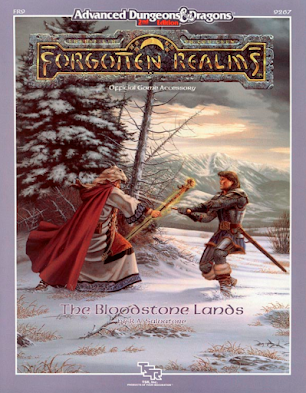Read Part 1 here and Part 2 here.
FR9 - The Bloodstone Lands
Full disclaimer, we spent years playing on this map in high school. There's a lot of nostalgia there, but also there was a lot of my DMs creativity that ran free during that time. The Bloodstone Lands allowed him to do it. You could own this and no other FR products and you get a 'here's a kingdom, there's these towns here, this barony there, and here's some influential shit that happened, now you fill in the rest'.
Historically, this takes place after the events of H1-H4, which you can happily ignore. Zhengyi's forces were overrunning Damara, the heroes defeated him, but the kingdom is left without a solid grasp on who the current king is. That's all you need to know.
The map is something I've run in my games plenty of times. I've converted into hexes, I've knitted together the surrounding kingdoms, and it saved me the trouble of naming a bunch of places and detailing every single city and town. While I've moved on from this recently, it gave me exactly what we needed for our groups in terms of: well-varied terrain, plenty of adventure rich locations, plenty of civilization and wilderness to explore, and it never once stepped on our nuts.
There is plenty of material inside that we never even got to. Like the adventures section, it gives you plenty of information to build on.
There's even a suggestion on how to play a campaign out, that we never used.
What we used was simply the map, the town guild, the history, and the major NPCs. If you wanted a setting that, especially at the time, didn't have a dozen novel NPCs that players may or may not have read about, where expectations were pre-set, and you felt like you were in a campaign straight jacket, this was the place for you.
FR11 - Dwarves Deep
Dwarves Deep was printed during a time when the product line was starting to fall apart. The actual game usefulness for some of the FR series (I'm looking at you FR7, 8, and kind of 10) was questionable. It was fluff. NPCs from novels that might have been cool if you and the other 15 year olds were constantly arguing over who was tougher, Drizzt or Dragonbait... Elminster or Raistlin... Wulfgar or Caramon... we did this. I'm not sorry. I digress.
Most of the FR products coming out were really just not something that were helping people run games. The FR line was going the way of the rest of the TSR product line, even leading the way. However Dwarves Deep brought it back to usefulness.
Information about families, runic alphabets, brotherhoods, clans were all good to see examples of. And if you're like me, you're not going to weave an entire Dwarven Civilization from nothing. This can save you some time to inform your design decisions. Why is this abandoned dwarf mine like this? What kinds of stuff can players find evidence of?
There's a lot of information on society and religion that can help that too, but you probably won't need it.
 |
| Too greedily and too deep? |
However, Dwarves Deep gives us The Great Rift. This isn't an adventure. It's an overview where it could be expanded into it's own setting by itself.
There's a great section on The Lost Kingdoms which gives you just enough of a mental starter to form your own 'what remains of those lost Dwarven kingdoms?' What drove them out? Where did they go? What lives there now?
Finally, there is a dwarf name generator and information on Dwarven Runes (and Runestones, which is probably where Dwarrowdeep drew some inspiration). Seeing an example of the Runestone shows how the dwarves write in a wrapping spiral and how they express numerals. Little things like that help bring an old Dwarven ruin to feeling like one.
The Ruins of Undermountain
Often brought up in conversations about Megadungeons, Undermountain gets passed over. Why? Because it's not a full service Megadungeon. The boxed set just has three levels. And those three levels aren't even fully detailed. Over three massive, sprawling maps, there's 70 keyed locations. Some of them repeat too.
This thing requires patience to the degree of either 1) just taking stuff and moving it to your own dungeon or 2) sit down and key out a few hundred rooms yourself. Do you want to keep the ideas intact? Do you want to use the maps?
Whatever the answer is, there's cool keyed areas in here. There's not that many compared to the scale of levels covered. While the room descriptions are almost Arden Vol in length, but they are usually worth absorbing.
Fun fact about Undermountain. Portions of the maps were lifted from B1, B3, B5, and Empire of the Petal Throne.
If you ever found yourself looking for inspiration on how to set up some dungeon rooms, then flip this PDF open and pick a room at random. Most of the time you'll walk away with some pretty great ideas.







No comments:
Post a Comment